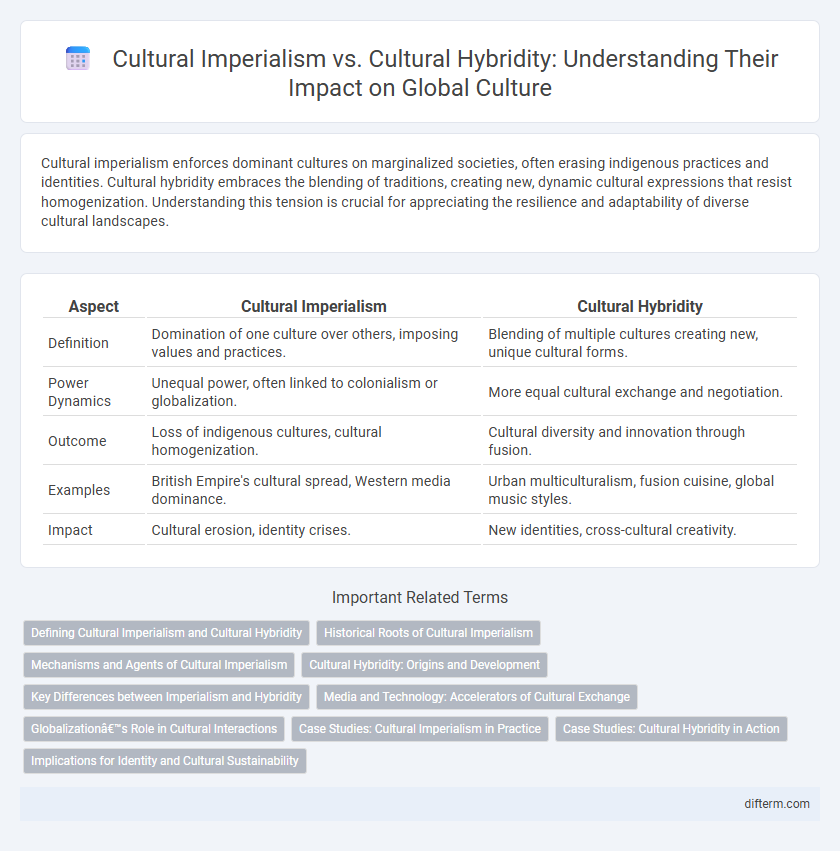Cultural imperialism enforces dominant cultures on marginalized societies, often erasing indigenous practices and identities. Cultural hybridity embraces the blending of traditions, creating new, dynamic cultural expressions that resist homogenization. Understanding this tension is crucial for appreciating the resilience and adaptability of diverse cultural landscapes.
Table of Comparison
| Aspect | Cultural Imperialism | Cultural Hybridity |
|---|---|---|
| Definition | Domination of one culture over others, imposing values and practices. | Blending of multiple cultures creating new, unique cultural forms. |
| Power Dynamics | Unequal power, often linked to colonialism or globalization. | More equal cultural exchange and negotiation. |
| Outcome | Loss of indigenous cultures, cultural homogenization. | Cultural diversity and innovation through fusion. |
| Examples | British Empire's cultural spread, Western media dominance. | Urban multiculturalism, fusion cuisine, global music styles. |
| Impact | Cultural erosion, identity crises. | New identities, cross-cultural creativity. |
Defining Cultural Imperialism and Cultural Hybridity
Cultural imperialism refers to the dominance of one culture over others, often through media, language, and economic influence, resulting in the erosion of local cultures. Cultural hybridity, on the other hand, describes the process where elements from multiple cultures blend to create new, hybrid cultural forms that resist singular cultural dominance. These concepts highlight contrasting dynamics in the global cultural landscape--one emphasizing cultural dominance and homogenization, the other emphasizing cultural exchange and transformation.
Historical Roots of Cultural Imperialism
Cultural imperialism originated during the era of European colonial expansion from the 15th to the 20th century, when dominant powers imposed their language, religion, and social norms on colonized societies. This process reinforced unequal power structures by marginalizing indigenous cultures and prioritizing Western ideals through political control, education systems, and media dissemination. Historical examples include British colonial rule in India and French imperialism in Africa, where cultural assimilation was a significant strategy for maintaining dominance.
Mechanisms and Agents of Cultural Imperialism
Cultural imperialism operates through mechanisms such as media dominance, language imposition, and economic control, enabling powerful nations to disseminate their cultural values globally. Agents of cultural imperialism include multinational corporations, global media conglomerates, and state institutions that promote their cultural products and ideologies across borders. These forces often marginalize local cultures by prioritizing Western norms and consumer behaviors, leading to cultural homogenization rather than genuine exchange.
Cultural Hybridity: Origins and Development
Cultural hybridity originates from postcolonial theory, emphasizing the blending and merging of different cultural elements to create new, dynamic identities. It challenges the binary opposition of colonizer and colonized by highlighting how cultures interact, adapt, and transform through processes such as globalization and migration. This concept has developed through works of scholars like Homi Bhabha, who argue that hybridity generates innovative cultural expressions that resist cultural imperialism's dominance.
Key Differences between Imperialism and Hybridity
Cultural imperialism involves the dominance of one culture over others, often leading to the erosion of local traditions and identities through the imposition of foreign values and practices. In contrast, cultural hybridity emphasizes the blending and merging of diverse cultural elements to create new, syncretic identities without erasing the original cultures. Key differences include imperialism's top-down imposition versus hybridity's bottom-up, reciprocal cultural exchange fostering innovation and diversity.
Media and Technology: Accelerators of Cultural Exchange
Media and technology serve as powerful accelerators of cultural exchange, driving both cultural imperialism and cultural hybridity. Global media conglomerates often dominate local markets, spreading Western values and content that exemplify cultural imperialism. Conversely, digital platforms enable the blending of diverse cultural practices, fostering cultural hybridity through collaborative content creation and cross-cultural communication.
Globalization’s Role in Cultural Interactions
Globalization accelerates cultural interactions, often intensifying cultural imperialism by spreading dominant cultural norms and consumer practices worldwide, particularly from Western countries. However, it also fosters cultural hybridity, where local cultures adapt, blend, and reinterpret global influences to create new, hybrid cultural expressions. This dynamic interplay reshapes identities and enables more diverse cultural exchanges beyond mere dominance or assimilation.
Case Studies: Cultural Imperialism in Practice
Cultural imperialism manifests in case studies such as the global spread of American fast food chains and Hollywood films, which often overshadow local traditions and media industries. These examples highlight the dominance of Western cultural products in shaping consumer preferences and social norms worldwide. Resistance to this domination frequently leads to cultural hybridity, where local cultures blend imported elements with indigenous practices, creating unique hybrid identities.
Case Studies: Cultural Hybridity in Action
Cultural hybridity manifests in diverse contexts where globalization intersects with local traditions, creating innovative expressions such as the fusion of Afrobeat and Western pop in contemporary music scenes. Case studies like the blending of Indian and British cultural elements in food, fashion, and film demonstrate how hybrid identities challenge the dominance of cultural imperialism by fostering mutual exchange and adaptation. These examples highlight the dynamic processes through which cultural hybridity resists homogenization, promoting pluralism and new cultural narratives.
Implications for Identity and Cultural Sustainability
Cultural imperialism often leads to the erosion of indigenous identities, imposing dominant cultural norms that threaten cultural diversity and sustainability. In contrast, cultural hybridity fosters the blending of different cultural elements, promoting dynamic identities and enhancing cultural resilience. This interplay significantly influences how communities negotiate identity preservation while adapting to global cultural flows.
Cultural Imperialism vs Cultural Hybridity Infographic

 difterm.com
difterm.com